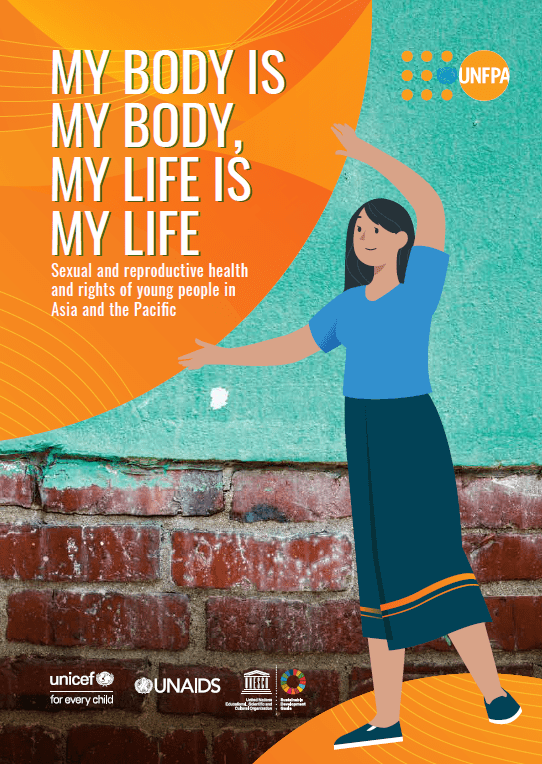Featuring UNFPA’s latest report: ‘My Body is My Body, My Life is My Life’
Just in the beginning of this year, the Share-Net International Co-Creation Conference 2021 was held which was focused on the theme ‘SRHR for Adolescents and Youth’. Five young people delivered Powertalks where they shared their experiences and stories in regards to menstruation, fighting social stigma and working as change-makers in the society.
Stigma and taboo related to SRHR, which is highly evident in the Asia and the Pacific region, makes an adolescent or young person’s health, well-being and growth a major challenge to achieve. Thus this is to feature UNFPA’s latest and one of their most important publications this year: ‘My Body is My Body, My Life is My Life: Sexual and reproductive health and rights of young people in Asia and the Pacific’.
The generation of young people of today is the largest in human history: globally, 1.8 billion people are aged between 10-24 years, accounting for a quarter of the world’s population. 60% live in Asia and the Pacific. In this complex world, while some problems these young people face aren’t new, technology advances have exacerbated issues they face. Experience of gender, racial and ethnic discrimination remains, and poverty and limited access to information and services are major barriers to good health outcomes for a significant proportion of young people globally.
‘My Body is My Body, My Life is My Life’ is a review paper which highlights the current status of sexual and reproductive health and rights (SRHR) of young people and finds out the key SRHR priorities in Asia and the Pacific region to support informed policy, programming and advocacy.
This report which provides an update of the 2015 report, has a particular focus on current evidence, policy and programme approaches related to key SRHR priorities in the region: child marriage and early union; adolescent pregnancy; young people with diverse sexual orientation and gender identity; SRH in a digital age; comprehensive sexuality education; and universal health coverage for adolescent SRH.
While progress has occurred, significant gaps remain in research and programming – leaving many of the SRH needs of young people unmet. Enabling young people to achieve the highest attainable standard of SRH is also a fundamental human right, reflected in international and regional agreements and commitments, and also the focus of several targets of the Sustainable Development Goals (SDGs). As Asia-Pacific seeks to build back better from the COVID-19 pandemic, the rights and choices of young persons are more crucial than ever for an equitable future where no one is left behind.
This report comes with a package of a snapshot, seven factsheets and six videos that summarize key SRH issues affecting young people and provide practical guidance to address such issues. These communication assets can be used as a whole set or individually.
Findings of the report include:
- 1 in 3 women (34 million) aged 15-24 do not have their demand for family planning satisfied by modern methods
- Less than 1 in 4 sexually active unmarried adolescents are using a modern method of contraception
- In the majority of countries, less than half of 15-24 year olds with multiple sexual partners used a condom at last sex, signifying substantial sexual health risk for both boys and girls
- Around 1 in 8 births to adolescent girls aged 15-19 years are unintended
There are an estimated 3.6 million unsafe abortions each year among women aged 15-24 years - Maternal disorders are the leading cause of death of girls aged 15-19 years in the Pacific, and the second leading cause of death in South Asia
- One in two 15-24-year-old women in the Pacific, 1 in 4 in South Asia, and 1 in 6 in Southeast Asia have experienced physical and/or sexual intimate partner violence
- 1 in 2 adolescent girls report at least one serious problem accessing health care.
While the report identifies that progress has been made in addressing issues in some areas through introduced legislation, policies and programmes, it concludes that “weak systems and poor integration across sectors, entrenched gender inequality, and stigmatisation of adolescent sexuality outside of marriage continue to deny young people access to essential SRH information and services, and limits their agency with respect to their own SRH.”
“In many areas we still have a long way to go, particularly in meeting the needs of sexually active adolescents… Adolescents’ evolving capacity and their rights are simply not being realised.” Björn Andersson, Regional Director (UNFPA) Asia-Pacific Regional Office.
The report calls for urgent action to increase young people’s access to crucial SRH health care and information. Support needs to be tailored to meet the needs of different communities and it recommends the “full and meaningful participation of young people in the development, implementation and evaluation of policies and programmes if SRH and rights are to be realised for all young people in Asia and the Pacific.”
Just as it is for the young people in Bangladesh, good SRH for young people in Asia and the Pacific is vital for their healthy development and overall state of wellbeing.
Reference:



